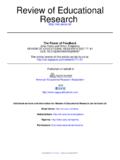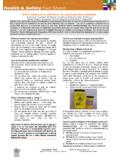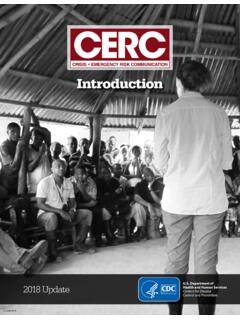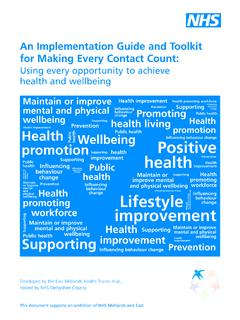Transcription of Advancing Partnerships - Parent and Community …
1 Advancing Partnerships Parent and Community engagement Framework Parent and Community engagementQueensland celebrates its diverse Community and recognises the integral role parents and families play as partners in their children s education. Our state schools play a critical role in supporting this diversity, engaging with the Community , and modelling and fostering respectful relationships between learners and all members of the engagement Genuine Parent engagement exists when there is a meaningful relationship between parents1 and teachers with the shared goal of maximising learning and wellbeing outcomes for students. Parents are generally a child s first teacher in their early years. A large body of evidence, spanning several decades, identifies the benefits of continued Parent engagement throughout schooling for student learning outcomes. Parent engagement has been shown to improve students self-esteem, school attendance, and behaviour at school.
2 In fact, Hattie (2008)2 estimated that effective Parent engagement could add the equivalent of 2 or 3 extra years to a child s engagement extends beyond Parent involvement in volunteering at the school, to having a deliberate focus on influencing and improving learning and wellbeing outcomes. Parents are provided with ideas and strategies and are encouraged to collaborate with the school and Community to strengthen Partnerships and directly assist in supporting their child s learning. Effective Parent engagement creates authentic relationships valued by each the mode of engagement will vary with the child s age, stage of learning, school and teachers, it may include parents: `being supported to understand ways to discuss learning goals and aspirations with their child `being kept up to date with their child s learning in the classroom and how they can support this at home `using appropriate games to improve their child s literacy and numeracy `being assisted to arrange effective learning spaces for their child `being assisted to develop effective strategies and techniques to enhance their child s engagement Community engagement refers to the establishment of sustainable relationships with the local Community to improve students learning and wellbeing outcomes and assist students to understand their role in the broader Community .
3 Community partners may include child and health services, Community organisations, sporting clubs, education and training providers, government organisations, local businesses and industry. Through these Partnerships , schools may increase their ability to offer a range of experiences, real life learning opportunities, support and resources that are not available within the school to improve students learning and wellbeing Partnerships can open pathways to better health and wellbeing for students and their families, assist in providing access to support services, and improve students future employment prospects and further education opportunities. Parents + Community With less than 15 per cent of a student s time spent at school each year, there are many hours in a day, week and year, in which parents, families and the Community can guide and influence students learning opportunities and outcomes through simple, low-cost and even no-cost, and teachers that take the time to establish and strengthen effective relationships with parents and the Community are finding that their efforts are being rewarded through improved outcomes for students and improved job satisfaction for Throughout the document, where the term Parent is used it refers to parents, carers, kinship and Hattie, J.
4 , 2008. Visible Learning: A Synthesis of Over 800 Meta-Analysis Relating to Achievement. communitiesQueensland comprises a diverse range of school communities, students, parents, families and teachers. Diversity should be celebrated and supported through an inclusive culture that promotes the skills and insights of all people irrespective of age, gender, ethnicity, generation, sexual orientation or to diversity may require additional strategies and considerations when forming collaborative relationships to ensure that the needs of the individual are considered and information is targeted to the specific effectiveness of any particular Parent or Community engagement strategy will depend on students learning needs and a wide variety of factors including communication preferences of teachers and parents; resources available in the local Community ; the range of cultures represented in the school Community , including Aboriginal and Torres Strait Islander cultures; the location of the Community including rural and remote communities.
5 And the proportion of working is important that the strategies used within a particular school or classroom are an effective match with the needs of teachers, parents and students, and that there is genuine commitment to improving learning and wellbeing outcomes together. The Parent and Community engagement Framework Queensland schools already use a range of strategies to successfully engage with their communities. The quality of these relationships directly influences the quality of current successes, Parent and Community engagement is an area in which schools can continue to innovate, renew and strengthen their approaches in recognition of the evidence that Parent and Community engagement has a positive effect on students wellbeing and Education: an action plan for education in Queensland recognises Partnering for success as making a critical contribution to a cohesive society and economic prosperity. School- Community Partnerships are recognised as a domain of the National School Improvement Tool (NSIT) which assists schools across Australia to review and reflect on their efforts to improve teaching and learning.
6 Schools that successfully implement school- Community Partnerships (Domain 9 of NSIT) will: actively seek ways to enhance student learning and wellbeing by partnering with parents and families, other education and training institutions, local businesses and Community organisations. Parents and families are recognised as integral members of the school Community and partners in their children s education. Partnerships are strategically established to address identified student needs and operate by providing access to experiences, support, and intellectual and/or physical resources not available within the Queensland s School Improvement Hierarchy provides a model to guide schools in their improvement journey and incorporates the nine domains of the NSIT. Domain 3 of NSIT, a culture that promotes learning, is also highly relevant to Parent and Community Parent and Community engagement Framework for Queensland state schools uses current evidence and best practice to provide a model that supports schools to enhance Parent and Community School Improvement Hierarchy5 elements of the Parent and Community engagement frameworkThis framework outlines five key elements of Parent and Community engagement to make a positive difference in our students education.
7 1. Communication Effective communication is an exchange between students, parents, communities and schools that is inclusive and involves information sharing and opportunities to learn from each other. 2. Partnerships with parents Partnerships between parents, students and schools promote student learning, wellbeing and high expectations for student Community collaboration Relationships between the school and wider Community strengthen the ability of schools and families to support student learning, wellbeing and developmental Decision-making Parents, students and Community members play meaningful roles in school School culture Respectful relationships between students, parents and the school Community are valued and enhance the promotion of student learning and ective communication is an exchange between students, parents, communities and schools that is inclusive and involves information sharing and opportunities to learn from each other.
8 Partnerships WITH PARENTSP artnerships between parents, students and schools promote student learning, wellbeing and high expectations for student COLLABORATIONR elationships between the school and wider Community strengthen the ability of schools and families to support student learning, wellbeing and developmental CULTURER espectful relationships between students, parents and the school Community are valued and enhance the promotion of student learning and , students and Community members play meaningful roles in school of strong Parent and Community engagement Schools seeking to assess their engagement success should consider whether: `the school genuinely values two-way communication between parents and school personnel to ensure both Parent and school knowledge is used to inform practice `parents are part of the conversation about implementing inclusive school practices and provide input into school improvement planning (for example, through a school-based Community liaison officer) `every Parent feels welcomed and valued as part of the school Community , is comfortable expressing their views, and has means to contribute their views (for example, interpreters if required)
9 `every interaction occurring on the school grounds is respectful `parents are encouraged to take a genuine and close interest in the work of the school, are acknowledged as the first teachers of their children, and engage as partners in their children s learning and wellbeing `communication with parents provides information about where students are up to in their learning, what progress they have made over time and what they might do to support their children s further learning `respectful and caring relationships are reflected in the ways in which staff, students and parents interact and through the language they use in both formal and informal settings `the school has regular and ongoing ways of finding out what parents need to assist them to engage with their child s learning `parents can list the school s key expectations for behaviour, attendance and homework `the principal and teachers use many styles of communication appropriate for parents cultural backgrounds, availability and work arrangements `the principal and teachers regularly connect with the Parent /s of every child in the school `the principal and teachers connect with a wide range of Community members `there are mechanisms to build relationships with relevant members of the COMMUNICATIONE ffective communication between schools, parents, students and the Community forms the foundation for developing and maintaining Partnerships .
10 To have a significant impact on student outcomes, communication needs to be focused on student learning and wellbeing. It must also be a genuine exchange of information and ideas between the student, the school, the home and the have a responsibility to help parents understand the language of learning including the terms used by teachers in the classroom with students to communicate learning goals and expectations. This will assist parents to discuss learning with their child at home and to effectively communicate with teachers using a common language. Points to consider `Is student progress communicated to parents in a positive and meaningful way? How? Are parents advised of student s strengths as well as areas for improvement? `Is it clear what teachers and parents need to discuss? How? `Is the school using language that is clear and accessible to parents and students and helpful for exploring learning development, challenges and success?











